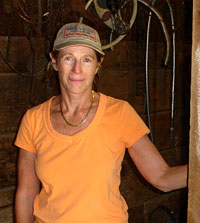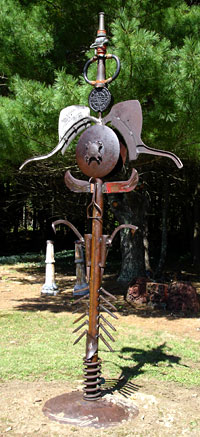Breathing New Life into Reclaimed Metal
 Artist Jill Nooney in her outdoor studio of reclaimed metal objects
Artist Jill Nooney in her outdoor studio of reclaimed metal objectsPhotograph by Paul David
New Hampshire artist Jill Nooney utilizes all sorts of recycled metal scraps for her garden sculptures. She collects copper, brass, bronze and steel pieces from saws, wood stove doors, wagons, gears from farm equipment - you name it - and combines these pieces to create works of art that depict everything from animals to abstract forms.
She doesn't mass-produce anything. This means that every piece is its own challenge, and Nooney doesn't usually plan her work. She looks at the metal pieces she has collected and begins to see associations and combinations, which inform the way her sculptures come together.
"Sometimes my husband and I will take apart two large pieces of farm equipment to get one of the major beams because if I have two of them, I can make an archway," she says. "We've taken apart pieces of equipment, and what I'm after is a small gear that's probably four inches long."
 Jill Nooney's whimsical sculptures composed of seemingly-common found objects take on a new life and look of their own
Jill Nooney's whimsical sculptures composed of seemingly-common found objects take on a new life and look of their ownPhotograph by Paul David
Often, the metal pieces begin to form an unmistakable image for her. Some pieces recently "just screamed elephants." Another sculpture that she created called "Tango" was built from two pieces that she found at a flea market. When she took the pieces apart and rearranged them, they suddenly looked like "two sexy couples."
Jill doesn't create custom work for clients because she never knows what she can make until she sees the metal pieces that are available to her. "It's not very fun to do things custom because you're always worried about pleasing [clients], and when I do it for myself, I only have myself to please. So, I feel much freer," Nooney explains.
She sells most of her pieces to New England residents, but she has shipped pieces to clients farther afield. She shipped a sculpture made from a heavy tractor wheel that was mounted on a piece of granite to someone in Iowa, who purchased it for his wife's 50th birthday. (The shipping cost was higher than the cost of the sculpture.)
Even though Nooney has a vast quantity of metal scraps at the moment, she always needs new pieces in order to stimulate her creativity.
"You can get so used to seeing it that you don't see it," she says of the pieces she collects.
It has become increasingly difficult to find metal scraps, however. The salvage yards that she frequented in the past are no longer allowing people to search on their properties. Apparently, safety and theft have been problems. So, she is actively looking for more sources and follows up on every possible lead.
Nooney's process involves fabricating the metal, usually by welding. She powder-coats and paints some of the metal, but she leaves the majority of the pieces in their rusted state, sealing them with an oil to preserve the velvety patina. Sometimes, she bolts the metal together, or she may simply slip a smaller pipe into a larger pipe. "I try and create them so I can disassemble them because I bring them to shows." She tries not to make the pieces so heavy that they can't be easily taken home. Nooney and her husband, Bob Munger, do this work on their own, which sometimes includes delivering the sculpture to a buyer's location where they reassemble it on site.
 Jill Nooney's reclaimed elephants
Jill Nooney's reclaimed elephantsPhotograph by Paul David
Nooney began her garden art when she had difficulty finding interesting sculptures for her own garden. She began making her pieces for herself, and this eventually led to a business, as well as the founding of a non-profit organization to protect Bedrock Gardens in New Hampshire, where several of her sculptures are displayed.
Her sculptures vary in size from 5 inches to 15 feet, but the average height is about 7 feet. "I like to do things that are vertical because they go so well in a garden," she adds. Nooney thinks specifically about how snow might fall on a piece, how a plant might come up around it or weave through it, and how to prevent the wind from blowing it over. She also thinks a lot about silhouettes and shadows since the work will be seen from all sides.
People often try to guess where the pieces in her sculptures originated, but usually, only the mechanically inclined can identify them. For example, at least two of her pieces are abstract figures with "hair" made from the steel filaments used in street cleaning equipment. She admits to a special fondness for farm machinery, however. "I do love the notion of machines that have worked the soil that return to the garden," she says. "And rust is earth color. It's very synergistic."
Resources:
Also in this Issue:
- Copper Holiday Ornaments: Reflecting the Warmth of the Season
- Breathing New Life into Reclaimed Metal
- Notes from The National Music Museum
- Copper Ken: The Musings of an Alchemist
- Ritual Beauty: Art of the Ancient Americas
